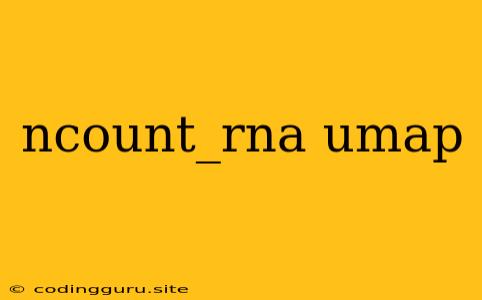Understanding ncount_rna and UMAP for Single-Cell RNA Sequencing Data
Single-cell RNA sequencing (scRNA-seq) is a powerful technique that allows researchers to study the gene expression profiles of individual cells within a heterogeneous population. This data can be used to identify cell types, understand developmental processes, and explore disease mechanisms. However, scRNA-seq data is often high-dimensional, with thousands of genes measured for each cell. This presents a challenge for visualization and analysis.
What is ncount_rna?
ncount_rna is a metric used in single-cell RNA sequencing analysis. It represents the total number of RNA molecules detected in a single cell. In essence, ncount_rna is a measure of the overall transcriptional activity of a cell.
Why is ncount_rna important?
ncount_rna is important because it can be used to identify cells that are actively transcribing genes versus those that are not. This is crucial because different cell types may have different levels of transcriptional activity. For example, cells that are actively dividing may have higher ncount_rna than cells that are quiescent.
How does ncount_rna relate to UMAP?
UMAP (Uniform Manifold Approximation and Projection) is a powerful dimensionality reduction technique used to visualize high-dimensional data. It is particularly well-suited for single-cell RNA sequencing data because it preserves the local structure of the data while reducing the dimensionality. The ncount_rna value is a feature that is often included in UMAP analysis.
How can ncount_rna be used in UMAP?
ncount_rna can be used in UMAP analysis in several ways:
- Coloring cells by ncount_rna: This allows you to see how transcriptional activity varies across different cell types or clusters.
- Filtering cells by ncount_rna: This can be used to remove cells that have low or high ncount_rna values.
- Using ncount_rna as a variable in the UMAP algorithm: This can help to improve the quality of the UMAP embedding and make it easier to identify cell types.
Example of ncount_rna in UMAP:
Imagine a study of a specific cell population. A UMAP plot is generated, and cells are colored by their ncount_rna values. The plot reveals that a cluster of cells at the upper-right quadrant of the UMAP plot have significantly higher ncount_rna than other cells in the population. These cells might represent a specific cell type, or they might indicate some kind of cellular activation or stress response.
Tips for using ncount_rna in UMAP analysis:
- Normalize ncount_rna values before plotting: This will make it easier to compare cells from different batches or experiments.
- Consider using a log transformation of ncount_rna: This will make the data more evenly distributed and easier to visualize.
- Experiment with different UMAP parameters: Adjust the
n_neighborsandmin_distparameters to fine-tune the UMAP embedding.
Conclusion:
ncount_rna is a valuable metric in single-cell RNA sequencing analysis, and it can be used in conjunction with UMAP to gain insights into the transcriptional activity of individual cells. By understanding ncount_rna and incorporating it into UMAP analysis, researchers can obtain a more comprehensive understanding of the complex dynamics of cell populations.
